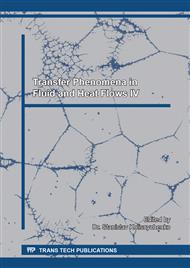[1]
T. J. Pedley, The fluid mechanics of large blood vessels, Cambridge University Press, Cambridge UK, (1980).
Google Scholar
[2]
F. T. Smith, Flow through constricted or dilated pipes and channels, Part I and part II, Quart. J. Mech. Appl. Math. 29 (1976) 343- 365.
DOI: 10.1093/qjmam/29.3.365
Google Scholar
[3]
C. G. Solomon, J. C. Grotta, Carotid stenosis, New Engl. Jour. Med. 369(12)(2013)1143–1150.
DOI: 10.1056/nejmcp1214999
Google Scholar
[4]
O. D. Makinde, T. M. Acho, P. Sibanda, E. M. Lungu, The bio-mechanics of atherosclerosis development, CAMES, 10(1) (2003) 23-31.
Google Scholar
[5]
D. F. Young, Fluid mechanics of arterial stenoses, J. Biomech. Eng. 101 (1979) 157.
Google Scholar
[6]
S. Chakravarty, Effects of stenosis on the flow behaviour of blood in an artery, Int. Jour. Engng. Sci. 25(1987) 1003-1016.
Google Scholar
[7]
S. Chakravarty, A. Datta, Pulsatile blood flow in a porous stenotic artery, Mathl. Comput. Model. 16(2) (1992) 35-54.
DOI: 10.1016/0895-7177(92)90005-6
Google Scholar
[8]
O. Prakash, O. D. Makinde, S. P. Singh,N. Jain, D. Kumar, Effects of stenosis on non-Newtonian flow of blood in blood vessels, Int. Jour. Biomath. 8(1) (2015) 1550010 (pp.1-13).
DOI: 10.1142/s1793524515500102
Google Scholar
[9]
L. Pauling, C. D. Coryell, The magnetic properties and structure of hemoglobin, oxyhemoglobin and carbonmonoxyhemoglobin, Proc. Natl. Acad. Sci. 22 (1936) 210–216.
DOI: 10.1073/pnas.22.4.210
Google Scholar
[10]
O. D. Makinde, P. Y. Mhone, (2006), Hydromagnetic effects on internal flow separation in a diverging channel. Rom. Jour. Phys. 51(9/10) (2006) 959-966.
Google Scholar
[11]
K. Haldar,S. N. Ghosh, (1994), Effect of a magnetic field on blood flow through an indented tube in the presence of erythrocytes, Ind. Jour. Pure Appl. Math. 25(3) (1994), 345–352.
Google Scholar
[12]
J. Prakash, O. D. Makinde, A. Ogulu, Magnetic effect on oscillatory blood flow in a constricted tube, Bots. Jour. Tech. 13(1) (2004) 45-50.
DOI: 10.4314/bjt.v13i1.15383
Google Scholar
[13]
O. D. Makinde, P. Y. Mhone, Heat transfer to MHD oscillatory flow in a channel filled with porous medium, Rom. Jour. Phys. 50(9/10) (2005) 931-938.
Google Scholar
[14]
O. D. Makinde, K. D. Alagoa, Effect of magnetic field on steady flow through an indented channel. A. M. S. E. Model. Measurement& Control B68(1) (1999) 25-32.
Google Scholar
[15]
E. E. Tzirtzilakis, A mathematical model for blood flow in magnetic field, Phys. Fluids 17(7) (2005) 077103.
DOI: 10.1063/1.1978807
Google Scholar
[16]
N. Verma, R. S. Parihar, Effects of magneto-hydrodynamic and hematocrit on blood flow in an artery with multiple mild stenosis, Int. Jour. Appl. Math. Comp. Sci. 1(1) (2009) 30-46.
Google Scholar
[17]
J. Creeze, J. J. W. Lagendijk, Temperature uniformity during hyperthermia: the impact of large vessels, Phys. Med. Biology 37(6) (1992) 1321–1337.
DOI: 10.1088/0031-9155/37/6/009
Google Scholar
[18]
T. C. Shih, H. S. Kou, W. L. Lin, Effect of effective tissue conductivity on thermal dose distributions of living tissue with directional blood flow during thermal therapy, Int. Commun. Heat Mass Trans. 29(1) (2002), 115–126.
DOI: 10.1016/s0735-1933(01)00330-x
Google Scholar
[19]
J. C. Chato, Heat transfer to blood vessels, Jour. Biomech. Eng. 102(2) (1980) 110–118.
Google Scholar
[20]
A. Shitzer, R. C. Eberhart, Heat transfer in medicine and biology- analysis and applications, Vol. 2, Plenum Press, New York and London (1985).
Google Scholar
[21]
J. Prakash, O. D. Makinde, Radiative heat transfer to blood flow through a stenotic artery in the presence of erythrocytes and magnetic field, Lat. Amer. Appl. Res. 41 (2011) 273-277.
Google Scholar
[22]
T. Chinyoka,O. D. Makinde, Computational dynamics of arterial blood flow in the presence of magnetic field and thermal radiation therapy, Adv. Math. Phys. 2014 (2014) 915640 pp.1-9.
DOI: 10.1155/2014/915640
Google Scholar
[23]
K. Khanafer, J. L. Bull, I Pop, R. Berguer, Influence of pulsatile blood flow and heating scheme on the temperature distribution during hyperthermia treatment, Int. Jour. Heat Mass Trans. 50 (2007) 4883-4890.
DOI: 10.1016/j.ijheatmasstransfer.2007.01.062
Google Scholar
[24]
O. D. Makinde, Asymptotic approximations for oscillatory flow in a tube of varying cross-section with permeable isothermal wall, Rom. Jour. Phys. 52(1/2) (2007) 59-72.
Google Scholar
[25]
G. F. Birchard, Optimal hematocrit: Theory, regulation and implications, Integ. Comparat. Biology 37 (1997) 65–72.
Google Scholar
[26]
M. M. Lih, Transport phenomenon in medicine and biology, JohnWiley and Sons, New York, USA (1969).
Google Scholar
[27]
M. Q. Brewster, Thermal radiative transfer and properties, John Wiley and sons Inc. New York, USA, (1992).
Google Scholar
[28]
A. Raptis, C. Perdikis, H. S. Takhar, Effect of thermal radiation on MHD flow, Appl. Math. Comput. 153 (2004) 645-649.
DOI: 10.1016/s0096-3003(03)00657-x
Google Scholar
[29]
T. Cebeci, P. Bradshaw, Physical and computational aspects of convective heat transfer, Springer, New York, USA (1988).
Google Scholar
[30]
O.D. Makinde, I. L. Animasaun, Bioconvection in MHD nanofluid flow with nonlinear thermal radiation and quartic autocatalysis chemical reaction past an upper surface of a paraboloid of revolution, International Journal of Thermal Sciences, 109 (2016).
DOI: 10.1016/j.ijthermalsci.2016.06.003
Google Scholar
[31]
O.D. Makinde, I. L. Animasaun, Thermophoresis and Brownian motion effects on MHD bioconvection of nanofluid with nonlinear thermal radiation and quartic chemical reaction past an upper horizontal surface of a paraboloid of revolution, Journal of Molecular Liquids, 221 (2016).
DOI: 10.1016/j.molliq.2016.06.047
Google Scholar


